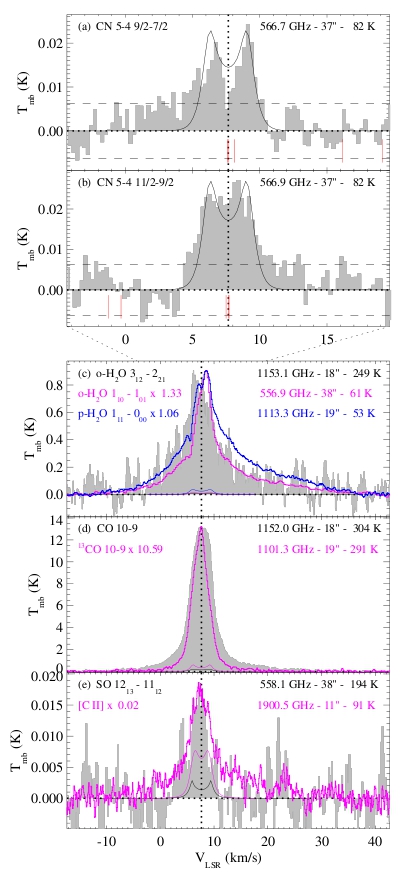| EPoS Contribution |
|
High-J CN lines: a powerful probe of the gas in embedded disks
Linda Podio INAF - OAA, Florence, IT | |
| The study of the physical and chemical structure of protoplanetary disks is crucial to comprehend the formation of planetary systems. Disks around non-embedded T Tauri and Herbig stars have been imaged in CO, and detected in a number of other millimeter (mm) and sub-mm molecular lines. On the contrary, the study of disks around more embedded systems is impeded by the associated envelopes and outflows which also emit strongly in the same molecular lines, hiding the fainter disk emission. Thus, it is crucial to identify a tracer to dig out the disk emission in those sources. We show Herschel/HIFI observations of the young multiple system T Tau in atomic and molecular lines. While CO, H2O, [C II], and SO lines trace the envelope and the outflowing gas up to velocities of 33 km/s with respect to systemic, the CN 5-4 hyperfine structure lines at 566.7, 566.9 GHz show a narrow double-peaked profile centered at systemic velocity, consistent with an origin in the outer region of the compact disk of T Tau N. Disk modeling of the T Tau N disk with the thermo-chemical code ProDiMo produces CN line fluxes and profiles consistent with the observed ones and constrain the size of the gaseous disk (R = 110 +- 20 AU) and its inclination (i = 25 +- 5 degree). The model indicates that the CN lines originate in a disk upper layer at 40-110 AU from the star, which is irradiated by the stellar UV field and heated up to temperatures of 50-700 K. With respect to previously observed CN 2-1 millimeter lines, the CN 5-4 lines appear to be less affected by envelope emission, due to their larger critical density and excitation temperature. Hence, this study demonstrates that high-J CN lines are a unique confusion-free probe of the gaseous disk of strongly accreting/ejecting sources and paves the way for future observations of embedded disks with ALMA. | |
 | |
| Caption: The figure shows Herschel/HIFI observations of T Tau in a number of atomic and molecular lines. At difference with H2O (panel c), CO (panel d), and SO, [C II] lines (panel e) which show broad profiles, the CN 5-4 hyperfine structure lines at 566.7, 566.9 GHz (panels a, b) show a narrow double-peaked profile centered at systemic velocity, consistent with an origin in the outer region of the compact disk of T Tau N. The line profiles predicted by the disk model of T Tau N calculated with the thermo-chemical code ProDiMo are overplotted. The model strongly underpredicts H2O, CO, SO, and [C II] lines which appear to be dominated by envelope/outflow emission. On the contrary, it produces CN line fluxes and profiles consistent with the observed ones and constrain the size of the gaseous disk (R = 110 +- 20 AU) and its inclination (i = 25 +- 5 degree). | |
| Collaborators: I. Kamp, Kapteyn, NL C. Codella, INAF-OAA, IT B. Nisini, INAF-OAR, IT G. Aresu, INAF-OAC, IT S. Brittain, Clemson U, USA S. Cabrit, Observatoire de Paris, FR C. Dougados, IPAG, FR C. Grady, Eureka Scientific, USA R. Meijerink, Kapteyn, NL G. Sandell, SOFIA-USRA, NASA, USA M. Spaans, Kapteyn, NL W.-F. Thi, IPAG, FR G. J. White, Open U, UK P. Woitke, SUPA, UK |
Key publication
Suggested Sessions: Cores to Disks |

